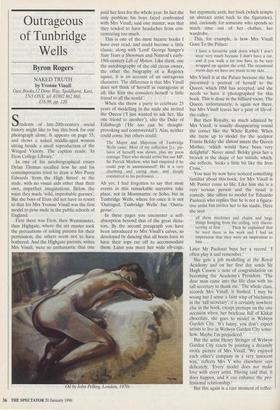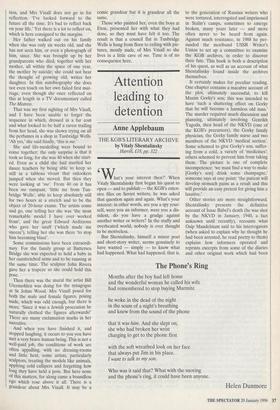Outrageous of Tunbridge Wells
Byron Rogers
NAKED TRUTH by Yvonne Vinall Oast Books,12 Dene Way, Speldhurst, Kent, TN3 ONX, tel: 01892 862 860, £16.99, pp. 120 Students of late-20th-century social history might like to buy this book for one photograph alone. It appears on page 55, and shows a naked middle-aged woman sitting beside a small reproduction of the Winged Victory. The caption reads: 'In Eton College Library.'
In one of his autobiographical essays Dylan Thomas recalled how he and his contemporaries tried to draw a Mrs Pussy Edwards 'from the High Street' in the nude, with no visual aids other than their own, imperfect imaginations. Below the waist they made 'wild, improbable guesses'. But the boys of Eton did not have to resort to that for Mrs Yvonne Vinall was the first model to pose nude in the public schools of England.
First there was Eton, then Westminster, then Highgate, where the art master took the precautions of asking parents for their permission; the others seem not to have bothered. And the Highgate parents, writes Mrs Vinall, were so enthusiastic that one paid her fees for the whole year. In fact the only problem his boys faced confronted with Mrs Vinall, said one master, was that they tended to have headaches from con- centrating too much.
This is one of the most bizarre books I have ever read, and could become a little classic, along with 'Lord' George Sanger's Sixty Years a Showman and Nimrod's early- 19th-century Life of Mytton. Like them, one the autobiography of the old circus owner, the other the biography of a Regency squire, it is an account of an outrageous character. The difference is that Mrs Vinall does not think of herself as outrageous at all; like Kim she considers herself 'a little friend to all the world'.
When she threw a party to celebrate 25 years of modelling in the nude she invited the Queen CI just wanted to ask her, like one friend to another'), also the Duke of Edinburgh (`He too can be thought- provoking and controversial'). Alas, neither could come, but others could:
The Mayor and Mayoress of Tunbridge Wells came. Most of my collection [i.e. pic- tures of herself] was shown, plus my press cuttings. Then who should arrive but our MP, Sir Patrick Mayhew, who had enquired if he could pop in unannounced? He is a very charming and caring man, and deeply committed to his profession...
Ah yes, I had forgotten to say that most events in this remarkable narrative take place, not in Montmartre or Soho, but in Tunbridge Wells, where for once it is not `Outraged, Tunbridge Wells' but 'Outra- geous'.
In these pages you encounter a self- absorption beyond that of the great dicta- tors. By the second paragraph you have been introduced to Mrs Vinall's calves, so developed by dancing that all boots have to have their tops cut off to accommodate them. Later you meet her wide rib-cage, Oil by John Pelling, London, 1970s her zygomatic arch, her back (which tempts an abstract artist back to the figurative), and, curiously for someone who spends so much time out of her clothes, her wardrobe.
This, for example, is how Mrs Vinall Goes To the Palace:
I have a favourite pink dress which I don't wear very much because I don't have a car, and if you walk a lot you have to be very wrapped up against the cold. The occasional warm days we have are music to my skin...
Mrs Vinall is at the Palace because she has presented a portrait of herself to the Queen, which HM has accepted, and she needs to have it photographed for this book. This is done in the billiard room. The Queen, unfortunately, is again not there, but Mrs Vinall leaves her a posy of lily-of- the-valley.
But then Royalty, so much admired by Mrs Vinall, is usually disappearing round the corner like the White Rabbit. When she turns up to model for the sculptor Franta Belsky she almost meets the Queen Mother, 'which would have been very delightful'. Never mind. Belsky gives her a brooch in the shape of her initials, which, she reflects, 'looks a little bit like the Iron Cross.'
You may by now have noticed something familiar about this book, for Mrs Vinall is Mr Pooter come to life. Like him she is a very serious person and the result is comedy. She offers to model for Eduardo Paolozzi who replies that he is not a figura- tive artist but invites her to his studio. Here she sees
all these machines and chains and huge things hanging from the ceiling, very discon- certing at first . . . . Then he explained that he used them in his work and I had an impression that they were an inspiration to him ...
Later Mr Paolozzi buys her a record. 'I often play it and remember.'
She gets a job modelling at the Royal Academy and on her first day sends Sir Hugh Casson a note of congratulation on becoming the Academy's President. 'The dear man came into the life class with his tall secretary to thank me.' The whole class, records Mrs Vinall, is hushed. I may be wrong but I sense a faint wisp of bitchiness in the 'tall secretary'; it is certainly nowhere else in the book, except perhaps on the one occasion when, her briefcase full of Kitkat chocolate, she goes to model in Welwyn Garden City. 'It's funny, you don't expect artists to live in Welwyn Garden City some- how. Maybe I'm prejudiced.'
But the artist Henry Stringer of, Welwyn Garden City reacts by painting a dreamily erotic picture of Mrs Vinall. 'We enjoyed each other's company in a very innocent way,' reflects Mrs V who elsewhere says delicately, 'Every model does not make love with every artist. Having said that, it does happen, and it can enhance the pro- fessional relationship.'
But this again is a rare moment of reflec- tion, and Mrs Vinall does not go in for reflection. 'I've looked forward to the future all the time. It's bad to reflect back on your life.' Yet there is a lot to reflect on, which is here consigned to the margins.
Her father walked out on his family when she was only six weeks old, and she has not seen him, or even a photograph of him, since. She was brought up by her grandparents who died, together with her mother, all within the space of one year, the mother by suicide; she could not bear the thought of growing old, writes her daughter. In this autobiography she does not even touch on her own failed first mar- riage, even though she once reflected on this at length in a TV documentary called The Mistress.
That was my first sighting of Mrs Vinall, and I have been unable to forget the sequence in which, dressed in a fur coat and what looked to be half a raven trailing from her head, she was shown trying on all the perfumes in a shop in Tunbridge Wells. `Ah yes,' she said finally, 'this is me.'
She and life-modelling were bound to come together; the only surprise is that it took so long, for she was 40 when she start- ed. Even as a child she had startled her dance teachers by being able to keep so still in a tableau vivant that onlookers jumped when she moved. But then they were looking at 'me'. From 40 on it has been me rampant, 'little me from Tun- bridge Wells', able to keep absolutely still for two hours at a stretch and to be the object of 20-hour exams. The artists come and go, one telling her she was 'the most remarkable model I have ever worked from', and the great Edward Ardizzone who gave her snuff ('which made me sneeze'), telling her she was there `to stop him becoming blasé'.
Some commissions have been extraordi- nary. For the family group at Battersea Bridge she was expected to hold a baby in her outstretched arms and to be running at the same time. The sculptor John Rivera gave her a trapeze so she could hold this pose.
Then there was the mural the artist Bill Utermohlen was doing for the synagogue at St Johns Wood. Mrs Vinall posed for both the male and female figures, posing nude, which was odd enough, but there is more. 'Since it was a Jewish procession he naturally clothed the figures afterwards!' There are many exclamation marks in her narrative.
And when you have finished it, and stopped laughing, it occurs to you you have met a very brave human being. This is not a well-paid job, the conditions of work are often appalling, with no dressing-rooms and little heat, some artists, particularly sculptors, treating the models like animals, applying cold callipers and forgetting how long they have held a pose. But here none of this matters, for along came a boundless ego which rose above it all. There is a grandeur about Mrs Vinall. It may be a comic grandeur but it is grandeur all the same.
Those who painted her, even the boys at Eton, presented her with what they had done, so they must have felt it too. The result is that a council flat in Tunbridge Wells is hung from floor to ceiling with pic- tures, mostly nude, of Mrs Vinall so she lives in a little cave of me. Time is of no consequence here.



























































 Previous page
Previous page